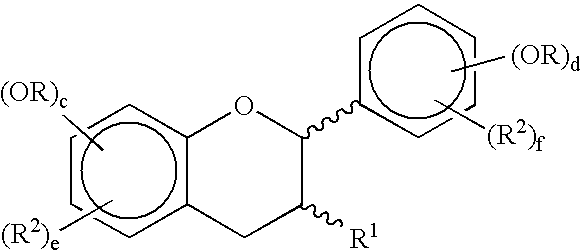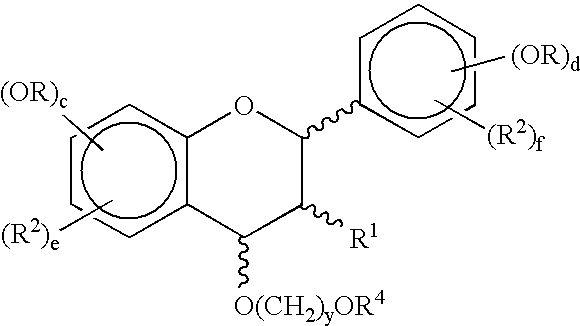Synthetic methods for polyphenols
a polyphenol and polymer technology, applied in the field of synthetic polyphenol monomers and oligomers, derivatives thereof, can solve the problems of increasing the size of oligomers, increasing the complexity of structural components, and not being satisfactory, and achieving the effect of improving the efficiency of current analytical methods of separation and purification
- Summary
- Abstract
- Description
- Claims
- Application Information
AI Technical Summary
Benefits of technology
Problems solved by technology
Method used
Image
Examples
example 1
[0357] Preparation of (2R,3S, trans)-5, 7, 3', 4'-Tetra-O-benzylcatechin
[0358] A solution of (+)-catechin (65.8 g, 226.7 mmol, anhydrous), dissolved in anhydrous dimethylformamide (DMF, 720 mL), was added dropwise, at room temperature over a period of 80 min, to a stirred suspension of sodium hydride, 60% in oil, (39 g, 975 mmol, 4.3 eq.) in DMF (180 mL). (S. Miura, et al., Radioisotopes, 32, 225-230 (1983)) After stirring for 50 min, the flask was placed in a -10.degree. C. NaCl / ice bath. Benzyl bromide (121 mL, 1.02 mol, 4.5 eq.) was added dropwise within 80 min. and the brown reaction mixture warmed to room temperature, with stirring, overnight. The resulting reaction mixture was evaporated and the resulting candy-like solid was dissolved, with heating and stirring, in two portions of solvent each consisting of 200 mL of chloroform (CHCl.sub.3) and 100 mL of water. The phases were separated, the aqueous phase extracted with CHCl.sub.3 (20 mL), and the combined organic phases wash...
example 2
[0360] Preparation of (2R)-5, 7, 3', 4'Tetrakis(benzyloxy)flavan-3-one
[0361] Freshly prepared Dess-Martin periodinane (39.0 g, 92 mmol, prepared by the method of D. B. Dess and J. C. Martin, J. Am. Chem. Soc. 113, 7277-7287 (1991) and R. E. Ireland and L. Liu, J. Org. Chem. 58, 2899 (1993)), was added at room temperature, all at once, to a stirred solution of the tetra-O-benzylcatechin according to Example 1 (54.4 g, 83.8 mmol) in methylene chloride (420 mL). Within 1.5 h, approx. 30 mL of water-saturated methylene chloride was added dropwise to the reaction mixture to form a turbid amber-colored solution. (S. D. Meyer and S. L. Schreiber, J. Org. Chem., 59, 7549-7552 (1994)) Twenty minutes thereafter, the reaction mixture was diluted with a saturated solution of sodium carbonate (NaHCO.sub.3, 500 mL) and a 10% aqueous solution of Na.sub.2S.sub.2O.sub.3. 5H.sub.2O (200 mL). The phases were separated and the aqueous phase extracted with 50 mL of methylene chloride. The combined organ...
example 3
Preparation of 5,7,3',4'-Tetra-O-benzylepicatechin
[0362] A 1 M solution of lithium tri-sec-butylborohydride in tetrahydrofuran, herein after THF, (100 mL, L-Selectride.RTM., sold by the Aldrich Chemical Co, Inc., Milwaukee, Wis.) was added, under an argon atmosphere, to a stirred, 0.degree. C. solution of anhydrous lithium bromide, LiBr, (34.9 g, 402 mmol) in 100 mL anhydrous THF. The resulting mixture was cooled to -78.degree. C., using an acetone / CO.sub.2 bath, followed by dropwise addition of a solution of the flavanone according to Example 2 (50.1 g, 77.2 mmol) in 400 mL of anhydrous THF, over a period of 50 min. Stirring was continued at -78.degree. C. for 135 min. The cooling bath was removed and 360 mL of 2.5 M aqueous sodium hydroxide (NaOH) was added to the reaction mixture. The reaction flask was placed in a room temperature water bath and a mixture of 35% aqueous H.sub.2O.sub.2 (90 mL) and ethanol (270 mL) was added over a period of 130 min. Stirring was continued overnig...
PUM
| Property | Measurement | Unit |
|---|---|---|
| temperature | aaaaa | aaaaa |
| [α] | aaaaa | aaaaa |
| [α] | aaaaa | aaaaa |
Abstract
Description
Claims
Application Information
 Login to View More
Login to View More - R&D
- Intellectual Property
- Life Sciences
- Materials
- Tech Scout
- Unparalleled Data Quality
- Higher Quality Content
- 60% Fewer Hallucinations
Browse by: Latest US Patents, China's latest patents, Technical Efficacy Thesaurus, Application Domain, Technology Topic, Popular Technical Reports.
© 2025 PatSnap. All rights reserved.Legal|Privacy policy|Modern Slavery Act Transparency Statement|Sitemap|About US| Contact US: help@patsnap.com



